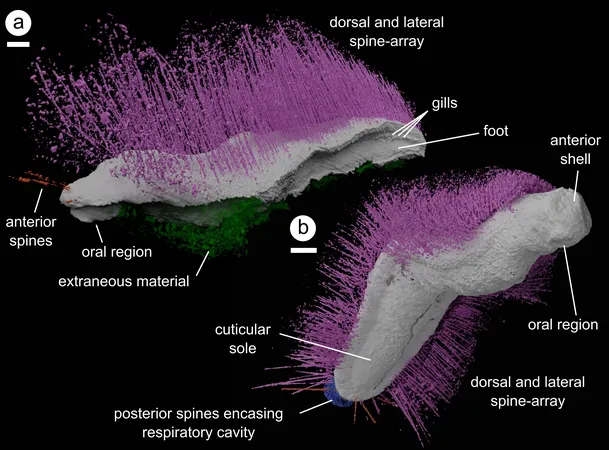
Meet Punk and Emo: Fossils That Revolutionize Our Understanding of Ancient Mollusks!
2025-01-08
Author: Charlotte
Groundbreaking Discovery
Researchers have made a groundbreaking discovery with the unearthing of two intriguing fossils, whimsically dubbed Punk and Emo. These fossils provide startling insights into the complexity and adaptability of ancient mollusks, challenging our conventional understanding of their early evolution.
Significance of Mollusks
Mollusks represent one of the most diverse groups of animals on Earth. The recently analyzed fossils, which date back an impressive 430 million years to the Silurian period, were excavated from Herefordshire, England. These findings radically transform our perception of mollusks, particularly those belonging to the Aculifera group, previously considered primitive and uncomplicated.
Scientific Classification
The fossils, scientifically known as Punk ferox and Emo vorticaudum, showcase remarkable features, suggesting that early mollusks were adept and diverse creatures. This discovery contradicts the historical view that these organisms lacked complexity, implying a rich evolutionary lineage more akin to other mollusk groups than previously believed.
Innovative Research Techniques
Utilizing cutting-edge imaging techniques, researchers recreated the fossils in stunning 3D models through X-ray scanning and careful segmentation. This sophisticated approach revealed Emo and Punk as pioneers of movement and form, showcasing a variety of adaptations previously undocumented in this group.
Expert Insights
Dr. Mark Sutton of Imperial College London led the study, collaborating with esteemed institutions such as the University of Leicester, the University of Oxford, and Yale University. He emphasized the rarity of such well-preserved fossils that allow for insights into the soft tissues of ancient organisms, saying, "The development of 'virtual fossils' offers us a treasure trove of knowledge about molluscan evolution."
Lifestyle Implications
Punk and Emo come equipped with unique features that hint at their lifestyles. The Emo fossil is intriguing; preserved in a folded position, it potentially mimicked inchworm locomotion, utilizing its spines for movement. Meanwhile, Punk's exact mode of locomotion remains a mystery, yet its unique ridge-like foot sets it apart from modern mollusks.
Naming and Characteristics
The quirky names Punk and Emo, initially devised as playful nicknames, reflect the fossils' distinctive characteristics. Punk's spiky appearance embodies the spirit of a rebellious punk rocker, while Emo’s design perfectly complements its counterpart, showcasing individuality.
Evolutionary Significance
Punk bears resemblance to worm-like mollusks but intriguingly possesses features such as a broad foot and gills typical of chitons, while Emo also reflects similar worm-like qualities with its elongated body. This extraordinary find not only enhances our understanding of ancient marine life but also invites further exploration into the evolutionary narratives of mollusks.
Conclusion
In a world often focused on the monumental and the sensational, this discovery reminds us of the intricate subtleties of prehistoric life that contributed to the rich tapestry of biodiversity we see today. As researchers continue to dissect these ancient marvels, the implications of Punk and Emo’s existence may unlock new chapters in the story of evolution. Prepare to be amazed as the annals of history reveal their secrets!



 Brasil (PT)
Brasil (PT)
 Canada (EN)
Canada (EN)
 Chile (ES)
Chile (ES)
 Česko (CS)
Česko (CS)
 대한민국 (KO)
대한민국 (KO)
 España (ES)
España (ES)
 France (FR)
France (FR)
 Hong Kong (EN)
Hong Kong (EN)
 Italia (IT)
Italia (IT)
 日本 (JA)
日本 (JA)
 Magyarország (HU)
Magyarország (HU)
 Norge (NO)
Norge (NO)
 Polska (PL)
Polska (PL)
 Schweiz (DE)
Schweiz (DE)
 Singapore (EN)
Singapore (EN)
 Sverige (SV)
Sverige (SV)
 Suomi (FI)
Suomi (FI)
 Türkiye (TR)
Türkiye (TR)
 الإمارات العربية المتحدة (AR)
الإمارات العربية المتحدة (AR)